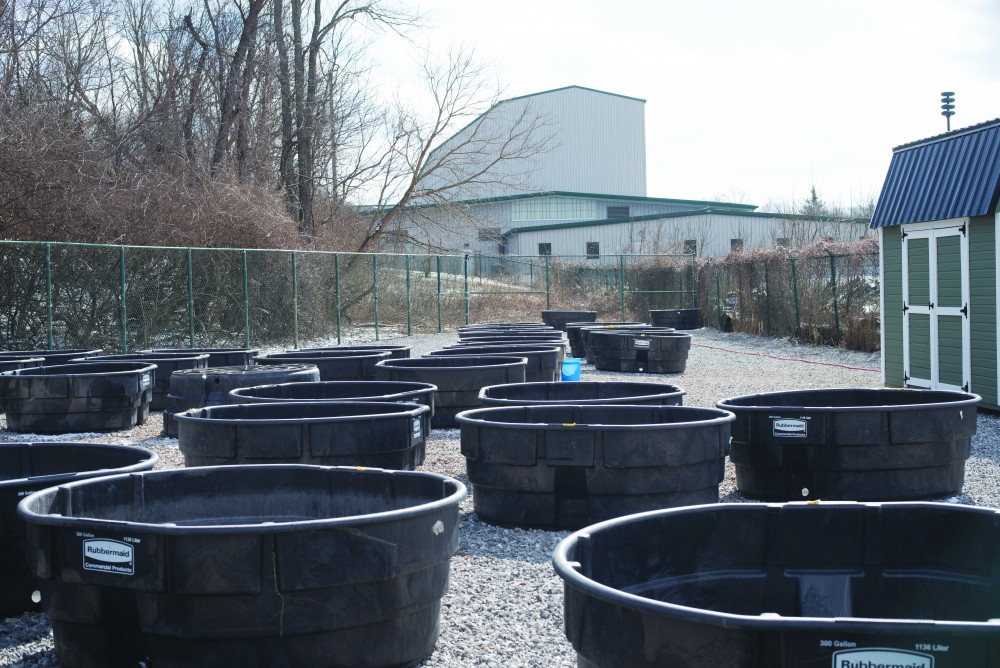Landing Page
Special Projects
This story is part of a series of specially designed stories that represents some of the best journalism The Post has to offer. Check out the rest of the special projects here.


Megan Knapp
3/7/2019
Ohio University researchers have set up a freshwater research facility after being awarded about $50,000 from the university’s 1804 Fund.
The Ohio University 1804 Fund, which was established in 1979 as a grant that focuses on undergraduate education, faculty research and graduate studies, was awarded to Biological Sciences researchers Kelly Johnson and Viorel Popescu.
The facility, located on West State Street, will allow research to be conducted using “mesocosms,” or large water tanks. They are traditionally used for cattle and are filled with leaf litter, zooplankton and other naturally occurring elements.
“The ‘meso’ is really kind of the middle, it’s like the best of both worlds, so to speak, between really trying to manipulate conditions to test hypotheses, and getting as close as possible to what is happening in the natural world,” Popescu said.Viorel Popescu
The mesocosms are designed to mimic vernal pools, or seasonal pools of water that provide a habitat for a diverse range of plants and animals. They will serve as an instrumental tool that allow researchers to bridge the gap between controlled lab studies which might not reflect natural conditions, and large observational studies where manipulating variables may be difficult.
“The ‘meso’ is really kind of the middle, it’s like the best of both worlds, so to speak, between really trying to manipulate conditions to test hypotheses, and getting as close as possible to what is happening in the natural world,” Popescu said.
This year marks the third year the mesocosms have been used. Cassandra Thompson, a graduate student studying for a doctoral degree in biological sciences, has used the mesocosms for the last two years to study how different environmental factors during the larval stage of amphibians affect the fitness of the adult animals.
Thompson specifically uses the Wood Frog in her research due to its ubiquity, and will use her findings to fill in a gap in the research on carryover effects during the lifecycle of an amphibian.
“There's kind of this mismatch and lack of connection between the aquatic and terrestrial stage in (population) modeling, so we want to be able to apply these carryover effects to larger population modeling,” Thompson said.
Thompson has watched the mesocosm facility transform from a series of cattle tanks in a muddy field into a fully fledged outdoor facility.
During the initial stages of the project, someone had tampered with the tanks, draining water from the pipes used to control water levels. Thompson said that one of the benefits of receiving the grant funding is extra security at a permanent facility.

Emilee Chinn | Emilee Chinn Photo Editor
Aquatic Mesocosm Center located on West State St.
In addition to fencing and other security deterrances, the 1804 Fund has allowed for the facility to have gravel around the tanks, as well as a shed to store equipment. It also allowed for the purchase of solar panels and batteries to sustainably power the different research tools used to test and monitor the mesocosms.
“Now that this thing is in place, it’s a really cheap way to do research,” Popescu said. “This is not (only) just interesting and sustainable, but also we can do really cutting edge research here at Ohio University.”
Aside from graduate research, the mesocosm facility will allow for undergraduates to get the field experience that will prepare them for internships and jobs, Thompson said.
There are already several students helping with Thompson’s research, and students are able to set up their own experiments at the facility. Undergraduate classes will also be able to go and do small research projects at a facility on campus, Popescu said.
This dual focus is part of why the mesocosm facility earned the 1804 grant.
The mesocosm facility was also an easy sell because “it was a perfect storm of things happening … all the pieces were (already) in the right place,” Popescu said.
The tanks had been purchased and were in use for several years, and Thompson’s research project had already received funding from the National Science Foundation through the NSF Graduate Research Fellowship, which she was awarded in 2017.
There is already interest in other projects that could be done with the mesocosms. Researchers from the Voinovich School of Leadership and Public Affairs are interested in doing a study on acid mine drainage and algal blooms, Popescu said. Plant biology researchers are also interested in using the mesocosms to study the ecology of algae.
“There’s a lot of people with a lot of good ideas on campus,” Popescu said. “So I’m sure it will be used continuously.”
BackLanding Page
This story is part of a series of specially designed stories that represents some of the best journalism The Post has to offer. Check out the rest of the special projects here.